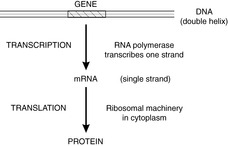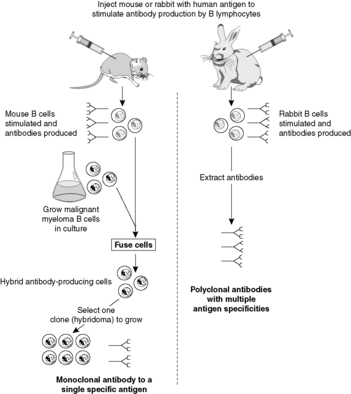from clinical reasoning to molecular biology
2.2 Laboratory methods11
Patients present with symptoms, and a clinical examination elicits signs that suggest a diagnosis. Examination of specimens such as blood, urine, faeces and tissue samples in the various pathology laboratories helps confirm this diagnosis and monitor the treatment.
• Diagnosis involves clinical skills and laboratory tests.
• Specialist pathological techniques can aid in diagnosis.
• The autopsy has a place in auditing the quality of diagnosis in addition to determining cause of death.
2.1. Diagnosis
Diagnosis is the act of recognising a disease in an individual patient and is based on clinical history, physical examination and investigation. The ability to integrate knowledge of the classification, epidemiology and mechanisms of disease processes, as discussed in Chapter 1, is essential. Making a diagnosis involves:
• taking a clinical history of symptoms: what the patient has noticed wrong (e.g. cough, breathlessness, pain)
• clinical examination for signs: what the doctor finds wrong on examination (e.g. lumps, rashes, abnormal lung sounds).
The clinician then works through a series of questions:
• Which organ system is most likely to be affected?
• Which category of disease do the signs and symptoms most likely suggest, e.g. inflammation, malignancy or poisoning?
• Do other factors such as race, age, sex, behavioural patterns or occupation of the patient provide clues to the diagnosis?
The diagnostic process involves testing a series of hypotheses based on the clinician’s knowledge of the frequency of occurrence of the symptoms and signs in different disease states and on the probability of these occurring in the population from which the patient comes. A list of possible diagnoses is constructed, known as the differential diagnosis, beginning with the most likely disease and progressing to include diagnoses which are less likely but are important to exclude.
Special investigations are used to refine the list of differential diagnoses by providing evidence consistent with some diagnoses but excluding others. In a sense, they test the hypothesis that a particular disease process is present in a patient. Special investigations can include radiology, isotope scans, and tests of body fluids and tissue in the pathology laboratories. Reaching a diagnosis enables the clinician to start treatment and to give the patient some idea of the outcome of the disease (prognosis).
The clinical laboratory disciplines
As a clinical subject, pathology grew up in side rooms adjacent to hospital wards where simple diagnostic tests could be performed by nurses, medical students and doctors, and in the post-mortem room where the morphological changes associated with disease could be observed at autopsy. As the number and complexity of tests grew, hospitals required centralised laboratories, staffed by dedicated technical and medical personnel.
Nowadays, clinical pathology is divided into a number of disciplines, each with its own specialist practitioners:
• Clinical chemistry or chemical pathology: the investigation of metabolic disturbances by changes in the concentration of substances in body fluids.
• Haematology: the study of diseases of the blood and bone marrow.
• Immunology: the study of diseases of the immune system.
• Medical genetics: the study of the inheritance of disease.
• Microbiology: the detection and characterisation of bacteria, viruses, fungi and parasites.
2.2. Laboratory methods
Histopathology
Histology
Basic histological techniques involve the processing of tissue specimens, so that they can be finely sliced and stained on a glass slide to be examined under the light microscope. Specimens can include biopsies (small pieces of tissue removed to make a diagnosis) and excision specimens (where a surgeon removes the diseased tissue as a therapeutic procedure). The tissue is first fixed in a preservative, usually formalin. It is then processed into paraffin wax, which supports the tissue while it is sliced into thin sections, typically 4–5μm in thickness.
Most histopathology laboratories use the haematoxylin and eosin (H&E) stain routinely. The haematoxylin dye stains basic molecules blue, such as nucleic acids, while the eosin stains acidic molecules red, such as proteins. Pathologists commonly use terms such as basophilic and eosinophilic for materials that take up haematoxylin and eosin, respectively. Other stains may be used in addition to H&E for some specimens to demonstrate a particular substance or structure better than in an H&E section. Some of these special stains are highly specialised and used rarely; others are used commonly in pathology (Table 2).
| Stain | Principle | Examples of diagnostic use |
|---|---|---|
| Reticulin | Silver impregnation of reticulin fibres (predominantly type III collagen) | Demonstration of the architecture of tissues, e.g. lung and liver, by outlining the reticulin network around cells |
| Trichrome | Dye binds to collagen | Demonstration of fibrosis in inflammatory and neoplastic processes |
| Periodic acid–Schiff (PAS) | Reacts with sugars and macromolecules rich in sugar residues | Demonstration of substances such as glycogen, mucin and basement membranes |
| Perls’ | Uses the Prussian blue reaction to demonstrate iron | Demonstration of iron deposits following inflammation or in haemochromatosis |
| Congo red | Dye is taken up by beta-pleated sheets | Demonstration of amyloid |
| Gram’s | Uptake and retention of dyes depends on qualities of bacterial cell walls | Demonstrates bacteria and divides them into two groups: Gram-positive (stain dark blue) and Gram-negative (stain pink-red). |
| Ziehl–Neelsen (ZN) | Stains acid-fast bacilli | Demonstration of mycobacterial infection |
| Giemsa’s | One of the Romanowsky family of stains that uses methylene blue and eosin | A routine stain for blood films and air-dried cytology specimens. Can also be used in tissue sections, for example to demonstrate certain parasites |
| Papanicolaou’s | A mixture of dyes gives good cellular morphology | The routine stain for fixed cytology preparations, e.g. cervical smears |
Sometimes clinicians require a very urgent diagnosis during surgery. If so, small amounts of tissue can be frozen quickly and sectioned in an instrument called a cryostat, and looked at within a few minutes (‘frozen sections’). Another use for frozen sections is to demonstrate fatty material in a specimen, because processing to paraffin wax dissolves any lipid out of the tissue.
It is also possible to look at tissues at a much higher magnification using the electron microscope. This technique, also known as ultrastructural examination, demonstrates cell structures at the level of organelles and smaller. It is relatively expensive and is generally used only in specific circumstances, such as the investigation of glomerular disease in renal biopsies. Viral particles in cells can be seen by electron microscopy.
Cytology
Sometimes it is easier or more efficient to take specimens of cells rather than whole pieces of tissue. Cells can be scraped from the surface (as in cervical smears), aspirated from various parts of the body through a fine needle, or separated from body fluids (such as urine, effusions or cerebrospinal fluid). The cells thus obtained can be placed directly on glass slides and stained to produce a cytological preparation, allowing abnormal cell morphology to be identified. Alternatively, the cells can be used for other techniques such as flow cytometry or detection of viral DNA.
Immunohistochemistry
Immunohistochemistry provides the pathologist with a powerful tool for demonstrating and identifying proteins, glycolipids and carbohydrates, which may be normal tissue constituents or produced as a result of a pathological process. Immunohistochemistry is based on the specificity of antibody-antigen binding. Monoclonal antibodies (antibodies having only one antigenic target) or polyclonal antibodies (a group of antibodies having a range of targets) can be made against a range of human antigens (Figure 1 and Ch. 7). Monoclonal antibodies are more specific. The antibodies can be applied to tissue sections or cytology preparations and will bind wherever their antigen is present. The antibody can be tagged either with an enzyme that catalyses a colour reaction or with a fluorescent dye. In this way the antibody and, by implication, the antigen can be visualised. A simple example is given in Figure 2.
Immunohistochemistry has enabled pathologists to learn much about the distribution of tissue antigens in both health and disease, and has increased the accuracy of diagnosis. Examples of diagnostic immunohistochemistry are given in Table 3.
| Antibody | Diagnostic use |
|---|---|
| Chromogranin | This component of neurosecretory granules can be used to locate neuroendocrine cells in tissues. It is also found in neoplasms of neuroendocrine type, e.g. carcinoid tumours and pancreatic endocrine tumours |
| Cytokeratin | The expression of cytokeratin by a tumour may help differentiate between an epithelial and a non-epithelial neoplasm. Sometimes specific cytokeratins can suggest a primary site, e.g. CK20 is typically expressed by carcinomas of the large intestine |
| Desmin | This filamentous protein is found in muscle cells. Its expression in a neoplasm implies muscle differentiation |
| Immunoglobulin | Identification of immunoglobulin in neoplastic plasma cells can aid in the diagnosis of multiple myeloma; identification of immunoglobulin in the tissues can help determine the immune nature of a disease, e.g. immunoglobulin in the renal glomerulus in glomerulonephritis (see Chs 7 and 8) |
| S100 | This protein is present in some cells (e.g. melanocytes, nerve cells and antigen-presenting cells), but not in others. It can be used to help determine the line of differentiation of neoplasms |
Molecular biology techniques
New techniques for looking at chromosomes, genes, DNA, RNA and proteins are being developed continuously. Some are still research techniques, but others have entered diagnostic practice and are described in this section. Familiarity with the structure of DNA and the ‘DNA-RNA-protein’ pathway (Figure 3) will help in understanding the principles of molecular biology.
 |
| Figure 3 |
In situ hybridisation
Molecular techniques can be used to determine whether specific DNA or RNA sequences are present in a specimen. A length of nucleic acid (the probe) with a complementary sequence to the DNA or RNA under study is constructed (see Box 1). The cDNA or cRNA probe is labelled with a radioisotope or a non-radioactive enzyme system and applied to a tissue section. Under the correct conditions the labelled probe will hybridise with its complementary nucleic acid sequence in the tissue. The specimen is then washed, and if the probe has attached itself to the specimen it can be detected by its label. In this way, the locations, numbers or types of cells containing the DNA/RNA can be seen down the microscope. In the relatively new procedure of fluorescent in situ hybridisation (FISH), the probe is attached to a fluorescent marker.
Box 1
• DNA is double stranded
• Bonds between complementary bases hold strands together (cytosine–guanine; adenine–thymine)
• Heat/alkalinise DNA – separation of strands (‘denaturation’) occurs
• Cool separated strands – complementary double strands re-form
• Labelled complementary single-strand DNA can identify a DNA sequence (e.g. a gene) in intact cells or disrupted cell preparations
Southern, northern and western blot analysis
Buy Membership for Pathology Category to continue reading. Learn more here









